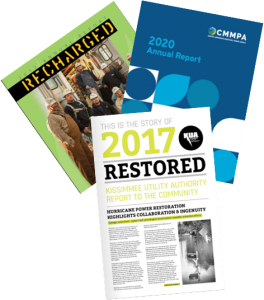
Congratulations! You have won the departmental lottery and now get to write this year’s annual report.
Don’t panic! When confronting the (potential) enormity of the task before you, remember the timeless advice shared by practitioners of long-format writing: “How do you eat an elephant? One bite at a time!”
All kidding aside, you have a big task, with plenty of pitfalls and dead ends. Your company’s annual report is a vital document that shows readers what your organization values, what it did over the prior 12 months to realize those values, and what it plans to do to continue living and delivering on its values.
No biggie, right? I mean, it’s not like there’s a lot of change going on in society or your industry, right?
But your annual report should be more than a bulleted check list of activities and accomplishments. Save that for your self-review at your annual performance review. Instead, this year’s annual report should have meaningful connective tissue to last year’s report, and lay some of the groundwork for next year’s report.
Think “the hip bone’s connected to the leg bone, the leg bone’s connected to the ankle bone.”
In theory, that should fit right in with your organization’s approach to major projects: they rarely are contained within the scope of 12 months. The RFP your company issued last year conditions the responses it receives this year, and will affect the work that is performed next year so that customers can have a better experience in two years.
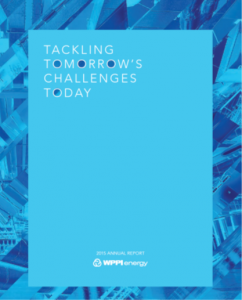
Step 1: Get Outside Yourself
The hardest part comes first: getting outside yourself and the views of your leadership team. What an internal audience might feel is important or interesting may, or may not, align with the views of your audience. At the very least, it’s going to require some careful thought, and maybe asking your leadership team a few questions. Such as, “Yes, but why is that important to readers?”
Start by diving into whatever market research your utility has collected. What’s uppermost in your customer’s minds? Probably not electricity, gas or water — unless they have been disconnected from those life-sustaining services!
Even if your organization has not surveyed customers for their thoughts, hopes, and fears, chances are that a local news organization, chamber of commerce, or college has conducted that type of top-of-mind survey. Maybe hot-button issues concern local employment, or social justice, or environmental protection. Depending on where you live and work, COVID-19 may be up there too.
Step 2: What Actions Map to Your Customer’s Concerns?
Whatever concerns your stakeholders, I expect your utility has been part of that conversation. Utilities and their communities are deeply interconnected with each other, so utilities’ actions should connect to the community’s concerns.
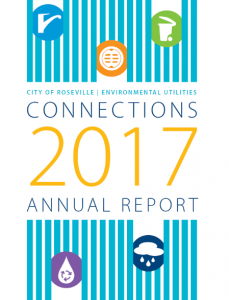
For example, if younger people — Millennials and Generation Z — are concerned about finding well-paying, purposeful jobs with security, showcase what you are doing to hire the best and the brightest. Show that your utility is a hub of technology by shining the light on recent hires who work on data analytics, electric vehicles, cybersecurity, environmental protection, or some other tech-driven job. See, you don’t have to climb poles to work at your local utility!
Or, as my friend and colleague Lincoln Bleveans wrote, “Utilities are the new cool.”
Of course, your community probably has been put through the emotional wringer by the COVID-19 pandemic. Show what your utility has done to respond to their concerns, whether it is suspending disconnections and late fees for non-payment of bills, or holding community food drives to feed those who are needy. One client created a $2 million fund to provide electric bill credits to those who have been economically damaged by the pandemic.
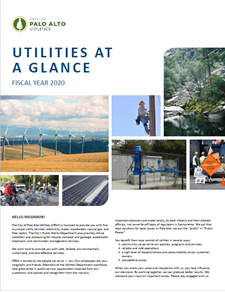
If sustainability is a community passion, showcase your utility’s efforts to shrink its carbon footprint and use resources more efficiently, and the steps it is taking to help their customers use water, electricity, and gas more efficiently. The City of Palo Alto Utilities did that in its “Utilities at a Glance” publication, which highlighted the utility’s efforts to operate more sustainably.
If your community has a high percentage of economically disadvantaged families, draw your reader’s attention to your utility’s efforts to address that group’s specific social-economic needs. Maybe employee volunteers are providing job-search mentoring to those who need it?
Perhaps your community has been blighted by drug abuse, gang violence, racial injustice or fatherless families. Utility employees are very community-oriented, so there is a good chance your employees are volunteering their time and talents to address persistent social ills locally.

Step 3: Show It by Telling Stories
Now comes the fun part: Compiling a list of stakeholders who have benefitted from the actions of your utility. You’ll need to spend time with the leadership team, of course, to gather ideas and perspectives that could go into the “President’s Letter.” I would recommend that this be the only section where the perspectives of leaders are featured.
As for the rest of the report, let your stakeholders do the talking!
- Showcase the customer who was able to spot water leaks quickly thanks to the utility’s installation of advanced digital meters.
- Focus on the heart-warming story of employees who donated money and time to buy and wrap Christmas gifts for the local senior center.
- Share the story of the high school student who got into the college of her dreams thanks to the tutoring provided by a utility employee.
- Discuss the car dealer who was able to sell more cars at night thanks to an LED lighting upgrade of the lot where cars are displayed.
- Feature a local water-utility customer who learned about the wastewater treatment process, also known as “what happens to the water after I flush the toilet?”
The utility annual reports I have most enjoyed writing, and that have won the most awards, have been those where I interviewed customers, community leaders, and business owners who have benefitted from something the utility did. I used their words and told the story from their perspective. Then I turned the proverbial camera around and profiled the employees who made those good things happen.
It’s one thing to say, “Our utility offers lighting upgrade programs for businesses,” but another for the manager of a senior center to welcome a lighting upgrade because it reduced the risks that residents with deteriorating eyesight would stub their toe, fall, and potentially injure themself.
Which story about lighting upgrades would you rather read?
Hopefully this three-step guide — I didn’t say the steps would be easy! — will help you write a better, more engaging annual report. And, if you don’t have the resources to do the job internally, I am always ready to take your call.
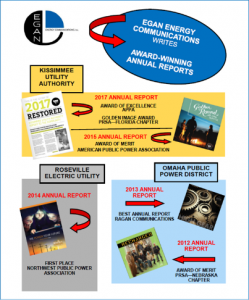
Annual Report Services by EEC
John Egan has written more than a dozen annual reports for public power and water utilities across the country over the last decade. Please check out the “Annual Reports” tab on the EEC Website Writing page for samples of these reports, many of them award-winning.
A Big Boost for Microgrids: Reliability, Resilience and Favorable Economics

Electric reliability is more important than ever. In response to rising community concerns about the need for higher electric reliability (often expressed as five nines), utilities increasingly are setting up microgrids to respond to the higher-reliability needs of manufacturers, hospitals, first responders, military installations and others.
Read John’s article in Public Power magazine here.

